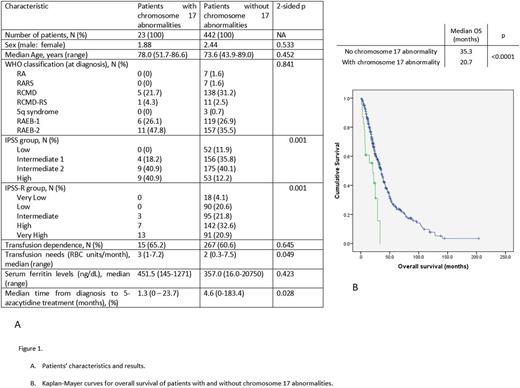Abstract
Introduction
Aberrations of chromosome 17 have been correlated to poor prognosis and resistance to treatment in several hematologic malignancies. Their role in myelodysplastic syndrome (MDS) has not yet been fully elucidated. Inversion of chromosome 17 (inv17) has been characterized as an intermediate risk cytogenetic abnormality in the revised International prognostic scoring system (IPSS-R), but chromosome 17 monosomy and other chromosome 17 abnormalities have not yet been fully characterized. Moreover, mutations of TP53 located on chromosome 17p, have been correlated to poor prognosis and resistance to treatment.
Aim
To determine the incidence and clinical significance of acquired abnormalities of chromosome 17 in adult patients with MDS treated with 5-azacytidine, in the context of the Hellenic 5-azacytidine registry.
Patients and methods
Patients diagnosed with myelodysplastic syndrome per the 2008 WHO classification were included in the study. Conventional cytogenetic testing was performed at diagnosis. All patients were treated with 5-azacytidine during the course of their disease according to common clinical practice. Demographic, clinical and laboratory data were recorded retrospectively (Hellenic 5-azacytidine registry). Statistical analysis was performed using IBM SPSS statistics, version 23.0 (IBM Corporation, North Castle, NY, USA).
Results
We analyzed the results of the cytogenetic analysis of 465 patients with MDS at diagnosis. Patients with chronic myelomonocytic leukemia, MDS/myeloproliferative neoplasm (MDS/MPN), and low-blast acute myeloid leukemia were excluded from the analysis. The main characteristics of the patients are shown in Figure 1A. We found 23/465 (4.9%) patients with chromosome 17 aberrations (6 with chromosome 17 inversion, 13 with a complex karyotype including chromosome 17 monosomy, 3 with a complex karyotype with add(17) and 1 with t(17;19)). All cases of inv(17) were found as an isolated cytogenetic abnormality, while all cases of chromosome 17 monosomy were found in the context of a complex karyotype. Abnormalities of chromosome 17 were the 7th more common cytogenetic abnormalities after complex karyotype and abnormalities of chromosomes 7, 8, 3, 5 and 12.
Patients with chromosome 17 abnormalities from our registry tended to be higher risk per both the IPSS and the IPSS-R. The median follow-up of the patients was 23.1 (0.7-203.8) months. Patients with chromosome 17 aberrations had a median overall survival (OS) of 20.7 months versus 35.3 months for patients without chromosome 17 aberrations (log Rank 2-sided p<0.0001, Figure 1B). Patients with any type of chromosome 17 abnormalities carried a worse prognosis than patients without abnormalities of chromosome 17 (OS was as follows: inv(17), 28.9 months; chromosome 17 monosomy, 20.7 months; add(17), 14.8 months; t(17;19), 5.7 months). Patients with a complex karyotype carried a poor prognosis irrespective of chromosome 17 aberrations. The presence of chromosome 17 abnormalities did not affect response to 5-azacytidine, and the rate of transformation to AML was comparable to that of the rest of the studied population. Moreover, t(17;19) has been correlated with poor prognosis in patients with acute lymphoblastic leukemia. Here we report for the first time the same chromosome abnormality in a patient with RAEB1 with poor prognosis.
Discussion
The present study evaluates the cytogenetic analysis of the largest, to our knowledge, cohort of patients with MDS treated with 5-azacytidine. Chromosome 17 abnormalities in patients with MDS comprise a group of cytogenetic disorders with poor prognosis since most of them are found in the context of a complex karyotype with the exception of inv(17) that occurs typically as a single cytogenetic abnormality. 5-azacytidine seems to be equally effective in patients with a complex karyotype with and without chromosome 17 abnormalities. Nevertheless, overall survival and survival after 5-azacytidine treatment remain short, although patients with inv(17) have a better prognosis from patients carrying other chromosome 17 abnormalities, with survival rates exceeding the historical control of 12 months for patients with high-risk MDS treated with best supportive care.
No relevant conflicts of interest to declare.
Author notes
Asterisk with author names denotes non-ASH members.


This feature is available to Subscribers Only
Sign In or Create an Account Close Modal